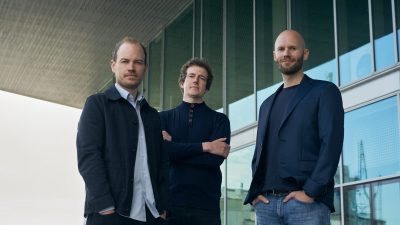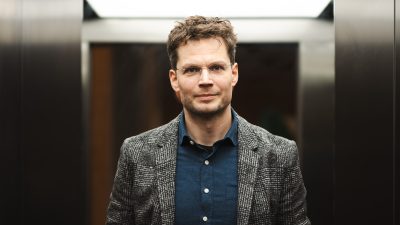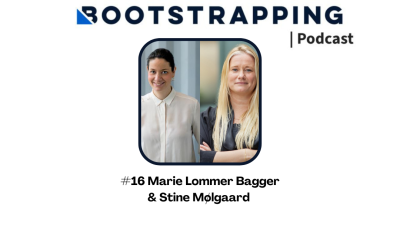
People, Culture & Startups #1 – Why the common rules of HR don’t apply in startups
We all know that it’s all about the founders and the team. But then…. This is the first post of a series of 5 inspiring posts where Frederik Vind will dive into different areas of the work with People & Culture in startups and scaleups. Frederik is actually Head of People & Culture at Nøie (just closed series A) and investor.
Let’s begin this post by killing the old Human Resources (HR) term. But why start a peaceful, hopefully insightful, post in such a brutal way? Well, it’s simple: The old HR term is not up to date with the core of its function. And it’s quite demeaning to be honest. As a term, HR was developed by an economist under Taylorismen ( A method for planning of production developed during the industrialization in the beginning of the 1900s) and it builds on the premise that humans are resources, on equal footing with e.g. material resources, in a production setup. In this way, humans are viewed on equal terms as other resources from that setup, e.g. electricity, components, etc. Many would argue that this perception is undermining human beings, and guess what: I most definitely agree. On top of that, such a view on people as static resources doesn’t give much room for talent, thoughts, synergies, and development.
In a startup, the common rules of HR, or the way HR is perceived in a corporate setting, do not apply. It’s fair to say that the best practice of HR in a startup changes a lot and it changes fast. Startups have no way of working following a process/yearly wheel mindset, commonly known from corporates. The rules, wished-for business outcome, the culture, and the people simply change too fast for such an approach to be fruitful. Now, this isn’t all bad: For a People & Culture nerd like me, this means that there’s a need for a more hands-on and active approach towards the strategic People & Culture function.
What really intrigues me about working with people, organisation, and culture in a venture-backed startup is the strong purpose and alignment that you will almost always find when revolutionizing a market and when working with an impact startup like Nøie, where purpose just becomes even stronger. At the same time, we have a close connection to external funding that keeps us all on edge and calls for a strategic People & Culture function that is even closer connected to the overall business.
Working with people, organisation, and culture in a venture-backed startup is something entirely else than doing so in an organically grown or bootstrapped company. And I must admit it really fascinates me. The reason for that is simple: External capital creates a forced growth journey, meaning faster than organic and that we can’t lean back and wait for things to come, we always have to drive the change and development. This calls for a different way of organizing, hiring, and firing. Also, the strategic work around culture needs to be adjusted to the specific growth stage the startup is in. To dive further into this, I’ve developed a model, inspired by the framework “Competing Values”.

The connection between growth stages and People & Culture
Above you see my own take on a startup growth journey and growth stages. It’s a two-by-two model with internal vs. market/external orientation on the horizontal line and flexibility vs focus on the vertical line. A startup starts its days in the yellow left corner with an ideation phase, basically where the idea is born. It then moves around the circle to test, scale, and improve (if it ever makes it that far).
From an organisational perspective, funding rounds mean more than just green faces on dollar bills: They act as catalysts for cultural change. In short, you can put it as:
- Ideation – Preseed
- Test (Market Fit) – Seed
- Scale – Series A, B, C etc.
- Improve – Exit or IPO
Every startup and company in general is naturally unique, but with the different funding rounds and the cultural catalysts from the growth stages, we’re actually able to build some overall logic into startup development. And this is where it becomes really interesting.
Growth stages
Ideation has an internal focus, where we’re trying to come up with a compelling offer that we’ll take to market. At this stage, we have an inwards facing culture working with full flexibility: We’re simply one happy family (clan culture), we don’t really care about roles and titles, we’re all just trying to come up with something new and innovative. Once we have come up with a solution/innovation, we want to test it in the market while still having full flexibility to make adjustments and pivots to the solution. We then move on to the testing phase in search of the mythical product-market fit. Once that’s achieved, fingers crossed, we lock it down and focus on scaling. Lastly, once a fair share of the market has been obtained, we look for an exit or an IPO to gain the synergies necessary for taking the company to the next level.
Looking at this from a people, organisational, and cultural perspective, the optimal setup changes quite a bit. There’s actually completely opposite needs in play when you’re in the “crossing stages” of e.g. ideation vs scale and test vs improve.
As an example, at the ideation stage we’re working as a clan (many like to call it family) culture with no real need or demand for titles and hierarchy. We’re all working closely together on developing something new without being very much in contact with the actual market. To succeed as leaders at the ideation stage is largely down to a matter of being facilitating mentors who create engagement and excitement about the future.
Having a look at the other side of the spectrum, reality flips with 180 degrees. At the scaling stage we know what we’re selling, why we’re selling it, and to who we’re selling. Here, it’s more a matter of going big and to do so fast, which calls for clear roles and a constant leveling of expectations and boundaries. This sets new demands for management, whose success now relies on being clear in communication and expectations. Every person throughout the organisation needs to know just how they can contribute to the overall success of the company, what metrics they’re measured on, and that they have the right conditions for succeeding in their respective roles.
Considering this, and looking at the stats, it’s no surprise that less than 20% of founders stay with a company after a Series B round. In short, it’s simply very different skills and traits that are needed at the different growth stages. That means that what was the source of your success at one stage as a founder will not work at the next stage. And that’s the number 1 reason why unlearning is so damn important in a startup. When that is said, I find the stats heartbreaking, and I do not believe that the answer is to let founders go. In fact, my motivation for working with this framework is that I believe that it’s a big loss that could have been prevented if we had a proper vocabulary for the development as well as the ability to plan and prepare for the future.
Who am I?
My name is Frederik and I’m the Head of People & Culture at Nøie.
At Nøie, we want to create the best products and services to increase the quality of life for people with skin issues throughout their life. We have just closed a Series A and we’re in the midst of scaling our entire organisation both within people, market and solution. We have experienced hands-on the shift from the market testing phase to the scaling phase, and how this shift brings the needs for a new form of organisation – not to mention communication, rhythms, and line of sight.
This is the first post of a series of 5 posts that’ll be shared bi-weekly. I’ll dive into different areas of the work with People & Culture in startups and scaleups. The next post is not written yet, so if you have any suggestions or ideas for a topic, please feel free to reach out.
Not to forget: As we’re scaling fast, we’re always on the lookout for talented people throughout the entire organisation. If you’re interested in working in an impactful scaleup, either visit our career site careers.noie.com or connect with me on LinkedIn and send a message.












Comments